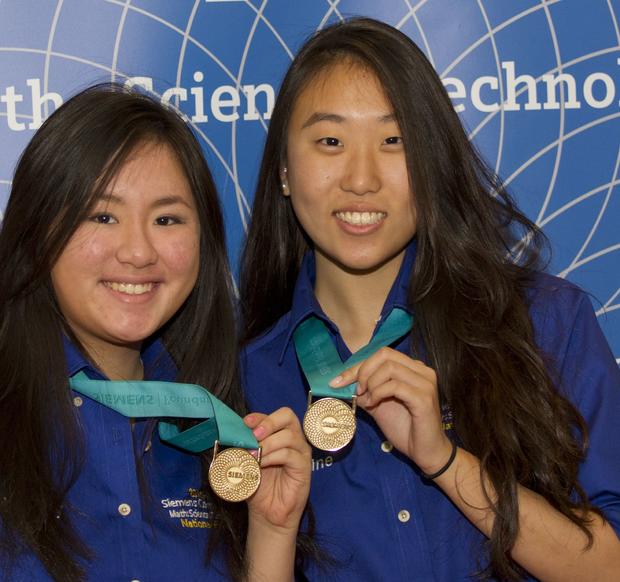Student scientists invent ways to clean up the planet
Maria Elena Grimmett, 17, was in sixth grade when she noticed that the well water at her Jupiter, Florida home was brown. With the dedication of a scientist twice her age, she spent the next six years devising a method for removing contaminants from her family's water supply.
Now a senior at Oxbridge Academy in West Palm Beach, Florida, Grimmett's research into a possible new water purification system has won her a $100,000 college scholarship and a top prize at the 2015 Siemens Competition in Math, Science & Technology.
"I was absolutely amazed," Grimmett told CBS News of the honor, which saw her work recognized out of a national pool of nearly 1,800 student project submissions. "It was great to be chosen from a group of such amazing students."
Grimmett was named the winner of the individual prize announced Tuesday at George Washington University in Washington, D.C.
What she discovered was a way of removing sulfamethazine, a commonly used veterinary antibiotic which can contaminate soil and aquatic ecosystems, from the water. Her method, utilizing small, reusable plastic beads, can be implemented using delivery systems already in place for treating drinking water, according to the Siemens Foundation.
In 2012, a paper she wrote about it was published in the Journal of Environmental Quality, which dubbed her "a young scientist to watch."
Two girls whose project focused on another way of cleaning up the environment took the top team award in the competition. Kimberly Te and Christine Yoo, 17-year-old seniors at Manhasset High School in Manhasset, New York, shared the $100,000 team prize for their efforts to find more cost-effective ways of cleaning up oil spills.
The two students -- who started out studying the impact pollution has on living organisms before they zeroed in on ways to clean up oil spills -- spent a year experimenting as they fine-tuned their research.
"We've always been interested in environmental sciences, in the prevalent problems surrounding the environment, in microbial technologies," Yoo told CBS News. "We wanted to see how much pollution there was in our water."
In the end, they designed a system that uses loofah sponge to soak up and degrade oil and then turns the otherwise unusable material into a source of clean energy. It took more than 1,500 hours of work, filling their free time on weekends and after school with research.
Part of the draw of the competition was the chance to present their work before a judging panel of nationally renowned scientists and mathematicians.
"It is something that is pretty cool -- having high schoolers show their work to professors who are from these top colleges," Te said.
Something that united all of the student researchers was a deep passion for science.
Te said her father exposed her to science from a young age, encouraging her to be curious, to ask questions, and to "just explore what's possible." Yoo, a self-described visual learner, said her interest was sparked by the "hands-on experience" of her fifth grade science lab.
Grimmett traced her enthusiasm to a third grade science fair, which gave her the chance to be creative when coming up with solutions to what were, at the time, difficult problems.
Allison Huenger, the science research specialist at Manhasset Senior High School, was one of the mentors overseeing Yoo and Te's project. She told CBS News she was impressed with the showcases from every student group at the competition -- and was gratified to see young women do so well.
"It's absolutely empowering. It's great to see so many females interested in STEM," Huenger said. "It's great to see these young women compete in a competition such as this."
Even though many programs exist to encourage girls and young women in STEM subjects -- science, technology, engineering and math -- their numbers lag far behind by the time it comes to filling jobs in competitive fields like engineering and computer programming. Top companies like Google, Apple and Yahoo admit their their technology staffs are still 70 to 80 percent male.
The nonprofit National Girls Collaborative Project find that while more girls than boys took advanced biology courses in K-12 education nationwide, more male students (42 percent) took physics classes than female students (36 percent). Male students were also six times more likely to take engineering courses.
But these girls are determined to make a difference in the field they love -- and they're off to an impressive start.
"I'm definitely going to pursue a science and engineering field," Grimmett asserted. "I'm not entirely sure exactly what. It's always hard to decide. There are just so many angles and options in science."

